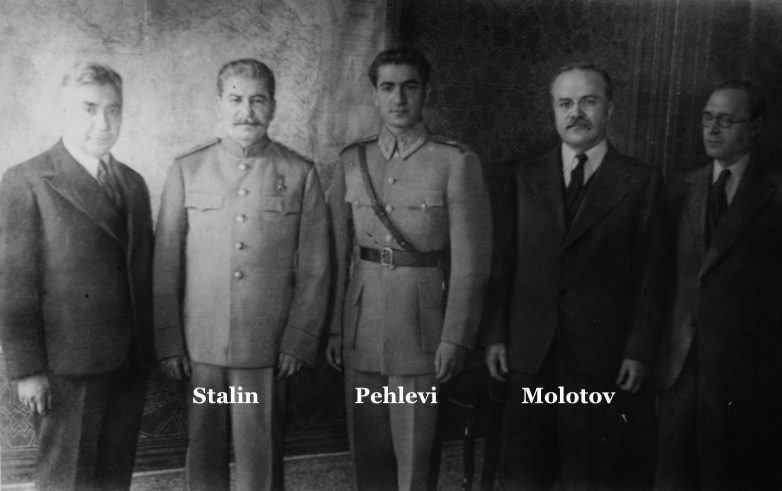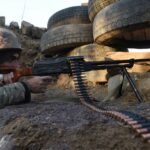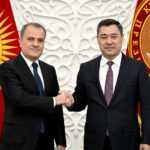Liberalism in the North, revolution in the South
In North Azerbaijan, split by the tsarist administration into governorates and uyezds of the Russian Empire, an active public thought was emerging, materialized in the establishment of political organizations, the publication of newspapers that expressed the socio-democratic, liberal-democratic views of the intellectual elite. The next stage in the development of the national liberation movement was the struggle for the establishment of an independent state.
And a statehood that was absolutely unprecedented in the history of Azerbaijan in terms of economic and defense power, a statehood with international standing—the Republic of Azerbaijan was founded at the modern stage by national leader Heydar Aliyev.

Meanwhile, the national liberation movement in South Azerbaijan reached the apotheosis of its development during the Iranian revolution of 1905-1911. And it was far from coincidence that the revolution, which was of both social and national-liberation nature and aimed to abolish the feudal system and establish a democratic one, took a concentrated form in the famous uprising of 1908-1909 in Tabriz, the capital of South Azerbaijan.
After the end of the World War II, the national movement of the South Azerbaijan, which flared up again due to certain geopolitical factors, was manifested in the emergence of the new Azerbaijani Republic in November 1945. At that time, elections were held for the National Assembly of South Azerbaijan, which submitted a demand for autonomy to Shah Reza Pahlavi and then established a 39-member National Committee and adopted an address to the Azerbaijani people, declaring the need for a “holy uprising”.
On December 12 of the same year the political leader of South Azerbaijan, Sayyed Jafar Pishevari, formed a government. On February 5, 1946, the national army of South Azerbaijan was established on the basis of the 77th division of the Soviet army, which had been in the territory of Iran since September 1941 in accordance with Article 6 of the Soviet-Persian treaty of 1921.
The national government established control over the banks, issued its own temporary banknotes, and introduced a state trading system. The Milli Majlis passed an agrarian law which provided peasants with allotments of former private and state land, a “Language Law” which declared Azerbaijani as the official state language. The University of Tabriz was established. Thus, South Azerbaijan turned into a territory completely outside Tehran’s control.
It is no longer a secret that the Soviet leadership intended to expand its territory by annexing South Azerbaijan to the Azerbaijani SSR.

It is a pity that Stalin lost
In an effort to prevent the Soviet Union from strengthening its position in the region and expanding its borders at the expense of South Azerbaijan, Great Britain made an unsuccessful attempt to press the UN Security Council to discuss the issue of Soviet withdrawal from this territory. But, failing to achieve a solution that would be acceptable to it, Britain sent additional troops to the south of Iran.
The situation, critical for the Iranian monarchy, forced it to recognize the limited autonomy of South Azerbaijan and give the Azerbaijani Majlis the status of a national elected committee. But this was a temporary tactic of the country’s Prime Minister Ahmad Qavam, aimed at stalling to suppress the democratic movement and openly bargaining with the Soviet Union for the right to develop the famous northern oil concession of Khoshtariya.
The unprecedented Anglo-American pressure on the USSR and the maneuver with the northern concession led to the Soviet troops leaving the territory of Iran in May 1946 by Stalin’s personal order, and on November 21, 1946 the Iranian government announced the deployment of its troops in the province. According to some reports, up to 20,000 supporters of independence of South Azerbaijan were summarily executed by punitive troops.
Despite the constant ethnic discrimination and endless reprisals carried out by the reactionary circles of Iran against socially and politically active Azerbaijanis, the fire of struggle for freedom and economic and socio-cultural conditions for their further development has not died out in their hearts. For it is incomprehensible that the 30-million Azerbaijani people in Iran does not have a single national school or printed publication in the Azerbaijani language. Meanwhile, there are 29 educational institutions and two newspapers in Armenian language, Alik and Araks, for all of 100,000 Armenians living in Iran.
This struggle subsided neither during Reza Pahlavi’s monarchical regime nor in the modern rigid theocratic totalitarianism.

Foggy Tabriz, again
The new Iranian revolution is also a telling testament to this. As it develops, the amplitude of the raised political slogans shifts from the expansion of the rights of ethnic minorities, including Azerbaijanis, to the overthrow of Khamenei and Raisi and the theocracy. Once again, as has happened many times in the history of Iran, the center of the protest movement is the capital of South Azerbaijan, Tabriz.
Azerbaijanis’ unquenchable thirst for national revival, at times latent and at times manifested in open protest movements of various socio-political nature, is certainly rocking the foundations of the anti-human regime, causing genuine concern of its authorities. And this concern is justified, as crowds of protesters in cities such as Tabriz, Qazvin and Zanjan are chanting slogans like “Long live Azerbaijan! May those who don’t want it go blind!”
The Azerbaijani protest movement initiated similar actions among other ethnic minorities discriminated against in Iran, such as Kurds, Arabs, Baluchis, Bakhtiaris, Turkmens, Gilyans, and Mazandarans, who took an active part in the protests. For the first time, almost all protesters in the country, including Persians, speak out against the political system itself, criticizing the authorities that persecute dissent, representatives of religious institutions, and the morality police, calling them “dishonest”.
However, the uncompromising nature and scale of the protest movement of the people of South Azerbaijan stem not only from their commitment to the struggle for national equality and independence, but also from the state’s essentially hostile foreign policy towards North Azerbaijan. This policy is wrapped in a thin diplomatic cloak. However, the facts speak for themselves.

There is a desire of aggressive circles of the IRI to give this hostility an ideological and legal framework. For example, in 2013, a group of Iranian MPs drafted a bill in which the Iranian government announced the termination of the Treaties of Gulustan and Turkmanchay. According to the authors of this bill, the division of historical Azerbaijan between Russia and Persia should be declared void. This implies the “right” of Iran to annex the entire territory of the currently independent Republic of Azerbaijan, despite the existing international imperatives to respect the territorial integrity of countries, the inviolability of their borders.
And this chauvinistic motive is by no means original or innovative. In Iran the territory of present-day Azerbaijan is called Aran, the Azerbaijan Democratic Republic, founded in 1918, included only Aran and Shirvan, and Tehran actively opposed the naming of the new state in South Caucasus after one of the Iranian provinces, Azerbaijan—this intriguing historical dossier can dot all the i’s and cross all the t’s.
What does Świętochowski say?
Tadeusz Świętochowski, Professor Emeritus of History at Monmouth University, wrote in his work Russian Rule, Modernizing Elites and the Formation of National Identity in Azerbaijan: “Until 1919 Iran formally put forward its claims to northern Azerbaijan, and in 1919, shifting to a more realistic position, it was negotiating a confederation with the independent republic. Only in the 1920s did Tehran begin to view the ties between the two parts of Azerbaijan as a threat to its new project of a national homogeneous Persian state.”

However, Tehran continues to view the strengthening of ties between the two parts of Azerbaijan as a threat to the existence of a national homogeneous Persian state.
At the same time, the Iranian establishment is now dominated by the maxim formulated by the deposed Shah of Iran Reza Pahlavi: “Without South Azerbaijan, Iran is a decapitated state”, implying that South Azerbaijan is the head of the Iranian lion depicted on its national emblem.
This chauvinistic approach to solving the problems of the people of South Azerbaijan, as well as relations with the northern Republic of Azerbaijan, only exacerbates the already tangled knot of traditional conflicts and contradictions. This is mirrored in the IRI’s foreign policy relations with official Baku.
Contrary to sound logic
While bound to Azerbaijan with the ties of the common Shia denomination, shared history and blood, Iran essentially supports Armenia, rattling weapons near the borders, providing blatant assistance to the separatist secession, which is tantamount to direct interference in internal affairs, and financially supporting anti-state religious groups. Meanwhile, favorable prerequisites for mutual cooperation between the two countries emerged after the end of the Second Karabakh War. In particular, for the establishment of regional cooperation within the framework of the “3+3” cooperation platform, as well as for the development of the North-South transport corridor, construction of the Khudafarin hydroelectric power plant, construction of a bridge over the Astarachay River and other issues…
But Iran has chosen a different path: it was from this perspective that Iran supplied fuel to Karabakh in the fall of 2021, which evolved into a more serious and even dangerous form of confrontation between the two states.
And despite President Ilham Aliyev’s warning that Tehran should not damage relations with Baku “for the sake of 25,000 people in Karabakh”, the large-scale “Conquerors of Khaybar” military exercise started on October 1, 2021 in the north-west of the IRI—in the territory of South Azerbaijan. This naturally begs the question: why didn’t Iran put on a similar military show near Armenia’s borders when Armenian gangs slaughtered 613 Shiites in Khojaly, instead of protecting Armenia in every possible way?

Iranian pro-Armenian bias is obvious!
The arrogance of Iran’s reactionary circles is unprecedented! However, any anti-Azerbaijani actions have had and will have a very adequate response.
And in order to prevent the people of South Azerbaijan from gaining vital freedoms even inside Iran, its authorities, securing the interests of the Farsi population alone, ignoring the second-largest demographic of their state, enter into an open alliance with all the enemies of Azerbaijan, primarily, with Armenia.
What is Iran afraid of?
Wary of the new rise of the national-democratic movement in South Azerbaijan, Iran does not hide its dismay at the defeat of the Armenian armed forces during the Second Karabakh War. Thus, Iran does not hide its interest in a longer border with Armenia and not with Azerbaijan.
The antagonism with its own Azerbaijani population and with all the representatives of the Turkic world makes Iran the most consistent ally of Armenia in all issues, including the problem of implementation of Paragraph 9 of the Trilateral Statement of November 10, 2020 on ensuring free passage of citizens and cargoes through the Zangezur corridor. Iran openly supports Armenia in this demarche on the issue of the fulfillment of its state-to-state commitments.

It means that Iran demonstratively opposes the strengthening of Azerbaijan in the event the Zangezur corridor that will connect it with its exclave, the Nakhchivan Autonomous Republic, and with its closest ally, Turkey, is built. To what extent does it meet the interests of the IRI itself, especially since Ilham Aliyev insisted that the project would be implemented “whether Armenia wants it or not”? After all, by exacerbating the confrontation with Azerbaijan, Iran disregards its own interests, because the corridor has the potential to become an important link in the East-West and North-South transport routes and will significantly increase the importance of Azerbaijan as a transport hub. Turkey will be able to transport its goods to Central Asia via a shorter route; Armenia will get a rail link to Russia, which was cut off more than 30 years ago. This will indeed somewhat isolate the Islamic Republic from Armenia, the only EEU country bordering Iran that has a free trade zone with the Eurasian Union, and contributes to the growing influence of Turkey…
Adem Ismailov, Doctor of Political Science
Translated from Haqqin.az










